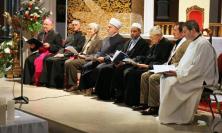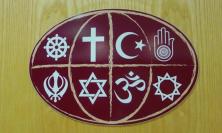Fifty years after the Second Vatican Council’s deliberations began, Jesuit theologian James Corkery explores the background to and content of one of his favourite documents of Vatican II, Dei Verbum. How did a last minute intervention from Pope John XXIII prevent the Council’s Dogmatic Constitution on Divine Revelation from becoming a very different document?
I have been teaching the topic of ‘revelation’ for about twenty years. That my former students tell me they still remember that the Latin word, revelare, means to ‘uncover,’ to ‘remove the veil’ is always a source of great consolation to me. Why? Because it conveys their rich conception of revelation that follows from that definition: it is God’s removing of the veil from the divine face so that men and women can come to know God – not just things about God, but God’s own self – in a personal, relational way. This understanding of revelation is elucidated most fully in a key document of Vatican II, a document which sees the character of revelation as being ‘dialogical’, ‘personalist’ and ‘experiential’, as we shall see.
However, the Second Vatican Council’s Dogmatic Constitution on Revelation, Dei Verbum, was nearly a very different document. But for the personal intervention of Pope John XXIII, our understanding of revelation might still be that promulgated by the First Vatican Council (1869-1870). So how did Vatican II change the way we think about revelation?
The Journey to Dei Verbum
Due to the intellectual character of the perceived challenges to Christian faith at the time of Vatican I, that Council conceived of revelation chiefly in propositional terms. Revelation consisted in statements made by the Magisterium about God; and faith, correlatively, was understood as assent to those statements. This understanding of revelation now seems narrow and intellectualist, and yet it would have prevailed were it not for the actions of Pope John XXIII towards the end of the first period of the Second Vatican Council.
A Preparatory Theological Commission, working under Cardinal Alfredo Ottaviani, head of the (then) Holy Office, presented a document, a so-called schema, ‘The Sources of Revelation,’ to the Fathers of the Second Vatican Council on 14 November 1962. This schema spoke in the same cognitive, propositional categories as the previous Vatican Council’s manner of speaking about revelation. But the Council Fathers were not happy with this schema and they showed their displeasure!
At a vote on the admissibility of the schema as a basis for the deliberations of the Council on 20 November 1962, some 60% of the Fathers voted ‘no’; but, according to the rules at the time, a two-thirds majority was required if a text was to be rejected (as well as accepted). Thus the outmoded schema would have survived had Pope John XXIII not waived the two-thirds requirement in the case of a rejection. A new Commission was founded to create a new text, with Cardinal Ottaviani now as joint head together with Jesuit Cardinal Augustin Bea, head of the Secretariat for Christian Unity, with whom Ottaviani did not see eye to eye! The action of the Pope led eventually to the production of the more nuanced, more ecumenical document on revelation that we shall now explore.[1]
‘Dialogical’
Joseph Ratzinger (now Pope Benedict XVI), commenting after Vatican II on Dei Verbum, homed in on how it sought to speak of revelation,
as a totality, in which word and event make up one whole, a true dialogue which touches man in his totality, not only challenging his reason, but, as dialogue, addressing him as a partner, indeed giving him his true nature for the first time.[2]
The word that jumps out from Ratzinger’s reflection is ‘dialogue’. It is an important category in his own theology and it names something of what both God and we are like. It is also an essential characteristic of the understanding of revelation that is at the heart of Dei Verbum (DV). Through this category God is seen to be personal and relational, and human beings are seen as shaped for encounter with this personal God. There is relationship here, a genuine two-sidedness, a mutual engagement between God and humanity. Evident, too, is the involvement of all three Persons of the Trinity in this act of divine self-revelation: the Son being the Word sent to us by the Father and the Spirit being given to us so that we are enabled to accept God’s Word in faith.
On God’s side, the high point of this dialogue is reached in Jesus, who makes visible the face of the invisible God (DV §4 and Jn 14:9; also DV §7). On our side, the high point in the divine-human dialogue is reached in the graced response of faith (DV §5), which completes revelation by means of the full-hearted ‘yes’ that we are enabled to say, through the action of the Holy Spirit, to the overtures of the self-disclosing God. This completion is facilitated by humanity’s meeting in history with Jesus Christ. To encounter God personally in Jesus is to come into face-to-face relationship with the living God in a way that is attuned to what is possible for our humanity and that takes into account how we actually are as human beings. God self-discloses, lovingly attentive to how we are shaped, fashioned, prepared, for such gracious self-bestowal. Karl Rahner had an eye for this; and once, made anxious by God’s immensity, he prayed that God might console him with a ‘smaller’ word:
You must adapt Your word to my smallness, so that it can enter into this tiny dwelling of my finiteness – the only dwelling in which I can live – without destroying it. If You should speak such an ‘abbreviated’ word, which would not say everything but only something simple which I could grasp, then I could breathe freely again.[3]
God does speak such an abbreviated word: ‘Jesus.’ (DV §4)
‘Personalist’
Because it manages to present revelation in relational and personal terms rather than in mere conceptual language, the genius of Dei Verbum is that it opens a window on God and a window on humanity. It shows God addressing us as friends out of the abundance of God’s love (DV §2) and moving among us in our lives and histories so that we can be drawn into the very life and relationships of the Trinitarian God (DV §3, 4). God relates to humanity, according to Dei Verbum, through words and deeds that have an inner unity: the deeds done by God in human history show forth and confirm the teaching and realities signified by the words, and the words proclaim the deeds and clarify the mystery contained in them (DV§2). Opting neither for an exclusively ‘words’ (propositional) approach, nor for an exclusively ‘deeds’ (revelation-as-events) approach to revelation, Dei Verbum speaks of God (or of Christ) disclosing themselves to human beings through what they say and through what they do (DV §2, 4, 14, 17). Here already there is a fuller understanding of revelation in evidence than there would have been if Vatican II had remained with the understanding of revelation put forward at the First Vatican Council.
Vatican II’s ‘dynamic, experiential and personalist’[4] manner of speaking about revelation makes it possible to treat the ways in which revelation is mediated to us in fresh and nuanced ways. Although revelation is personalist in character – that is, it consists first and foremost in personal encounter, relationship – this relationship can still be mediated via other sources. Chief among the ‘classical’ mediators of Christian revelation are the Scriptures and the entire ecclesial tradition. However, because revelation occurs in a manner that is personalist, its mediations cannot be understood in static or compartmentalized ways that fail to keep in view the ‘totality’ (recall Ratzinger) of what occurs in revelation; and the total and full response that it invites us to in faith (DV §5). So Dei Verbum is careful not to speak about Scripture and Tradition in lifeless, un-historical terms, or to view them as two completely separate sources of revelation. Rather it seeks to hold them together in a kind of dynamic, organic unity that mirrors its understanding of revelation itself as a living, personal encounter.
‘Experiential’
Resisting the tendency to conceive of Scripture and Tradition as two separate sources was just as significant an advance as overcoming Vatican I’s propositional model of reducing revelation to statementsof faith. Instead, thinking in personal and living categories, the Council was able to say that, ‘there exists a close connection and communication between sacred tradition and sacred Scripture. For both of them, flowing from the same divine wellspring, in a certain way merge into a unity and tend toward the same end’ (DV §9). This unity is dynamic: Scripture and Tradition are nourished by, and draw from, the one God. The former is the living word of God recording, in the writings of its inspired human authors, those truths necessary for our salvation. The latter is a dynamic, living reality that refers both to the process by which Christian faith is handed on and to the content of this same faith: ‘the church’s liturgy, theological reflection, doctrinal pronouncements, and daily insight of ordinary believers.’[5] The two together form a single treasury of the word of God that is entrusted to the Church, whose ‘living teaching office’ authentically interprets it, whether written or handed on (DV §10). Revelation itself, as a living encounter, will always exceed both Scripture and Tradition, as any living encounter will always exceed what can be written or stated about it. Similarly, while doctrinal pronouncements have a normative character as expressions of Christian truth that lead people reliably into a more saving relationship with God,[6] they do not equate straightforwardly with revelation itself. Tradition, Scripture and the Church’s teaching authority are joined and ordered to one another (DV §10) in such a way that, under the action of the Holy Spirit, they bring men and women forward towards the salvation that is disclosed through revelation, with the revelation itself always being richer than what can be written down or proclaimed about it.
The thread of dialogue
The Council’s journey from its first, rejected reflections on revelation through to the final text of Dei Verbum, approved on 18 November 1965, followed the ‘thread’ of dialogue, of ‘heart speaking to heart’ (to recall Newman, to whom Vatican II was said to belong). Thus the dialogical, personalist and experiential character of the relationship between God and humanity described in Dei Verbum flavoured the entire Council, and was the model to which all relationships should aspire: Catholics with one another (Lumen gentium), with other Christians (Unitatis redintegratio) and with men and women of other faiths (Nostra aetate). Dialogue was to be the primary pathway, with no-one being coerced in matters that had to do with conscience and faith. To allow this principle of dialogue, which suffused Vatican II in general and its reflections on revelation in particular, to inform all of our relationships would surely be a true sign of our fidelity to the Council, fifty years on.
James Corkery SJ is Associate Professor of Systematic Theology at the Milltown Institute.
[1] For most of this account of the fate of the initial schema, I rely on Giuseppe Alberigo, A Brief History of Vatican II (Maryknoll, New York: Orbis Books, 2006), p. 27.
[2] Joseph Ratzinger, ‘Dogmatic Constitution on Divine Revelation, Origin and Background’ in: Herbert Vorgrimler (ed.), Commentary on the Documents of Vatican II, 5 volumes (New York: Herder and Herder, 1967-1969), Vol. III, pp. 155-198, at p. 172.
[3] Karl Rahner, “God of My Lord Jesus Christ,” cited from Albert Raffelt (ed.), Prayers for a Lifetime (New York: Crossroad, 1984) in: Elizabeth A. Johnson, Quest for the Living God: Mapping Frontiers in the Theology of God (New York and London: Continuum, 2007), p. 39.
[4] These adjectives are from Dermot A. Lane. See The Experience of God: An Invitation To Do Theology. Revised edition (Dublin: Veritas Publications, 2003), p. 70.
[5] See Richard R. Gaillardetz and Catherine E. Clifford, Keys to the Council: Unlocking the Teaching of Vatican II. Collegeville, MN: Liturgical Press, 2012, pp. 36-37; see also p. 39.
[6] Ibid., see p. 37.
![]() Dei Verbum
Dei Verbum![]() Milltown Institute
Milltown Institute
![]() ‘50th Anniversary of Vatican II: The history and legacy of the council’ by Oliver Rafferty SJ on Thinking Faith
‘50th Anniversary of Vatican II: The history and legacy of the council’ by Oliver Rafferty SJ on Thinking Faith






